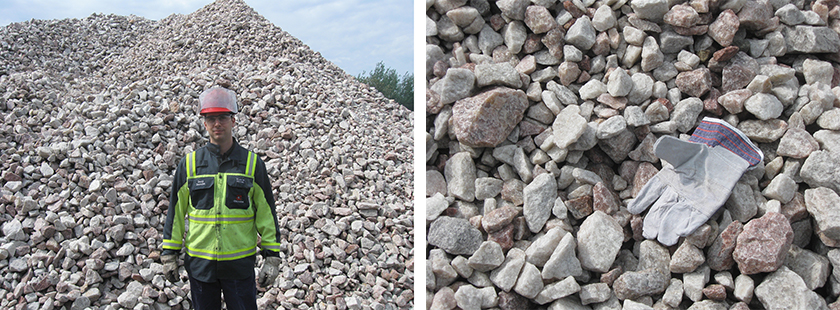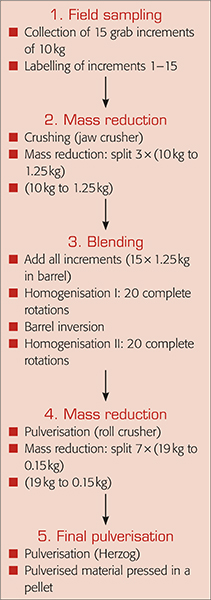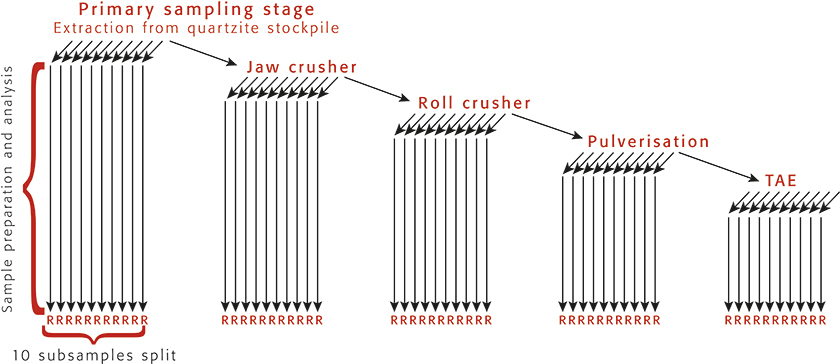L. Paul Bédarda and Kim H. Esbensenb
aProfesseur-chercheur, Université du Québec à Chicoutimi, Chicoutimi, QC, Canada.
http://www.uqac.ca/portfolio/paulbedard, E-mail: [email protected]
bConsultant, independent researcher, Dr (h.c.), www.kheconsult.com. E-mail: [email protected]
Introduction
The Replication Experiment (RE) was introduced and applied to different sampling contexts in an earlier column.1 Here we want to show its features and usefulness in the context of evaluating a possible new sampling + analytical approach for raw material characterisation in a demanding industrial context: “Representative sampling and use of handheld X-ray fluorescence (HHXRF) to characterise lot and sample quality of quartzite in a pyro-metallurgical ferrosilicon plant”.2 The issue has a very sharp focus: Is the HHXRF approach applied to field samples able to quantify very troublesome, minute amounts of pollutant trace compounds in quartzite for the ferrosilicon process with the necessary accuracy and precision? We here focus on the application of the RE only in the context of the full evaluation, a much broader study.3

Left: A big job awaiting MSc student Danny Desroches; photo taken just before it all began in earnest in front of a newly arrived raw material lot. Right: Close-up of the typical dimensional manifestation of quartzite blocks (safety glove for scale). Block surface flatness, which influences the quality of HHXRF analysis, is commented upon further in the text.
Industrial setting (Elkem Metal Canada ferrosilicon plant)
Elkem Metal Canada Inc. is a producer of ferrosilicon alloy. Production relies on two main pathways characterised, respectively, by a base of 50 % or 75 % silicon, with several customer-specified options, e.g. foundry and steel plants. For this type of production, the plant reduces quartz (SiO2) by a combination of melting in a blast furnace and Söderberg electrolysis. For this process to be successful, the composition of quartz (in the form of the raw material quartzite) must be carefully monitored and controlled. Contaminants, such as aluminium, can dilute the silica phase. Although quartz would appear to be a simple matrix, the low concentrations of impurities, for example, in the form of discrete minute grains of ilmenite (FeTiO3) or magnetite (Fe3O4) increase the difficulty of accurate analysis. These impurities exhibit an extreme degree of spatial heterogeneity in the raw quartzite lot and thus make proper sampling before, or associated with, analysis highly challenging. As the matrix is essentially SiO2 (> 98 % m/m), Elkem Metal does not analyse individual whole shipments of quartz but instead relies on traditional grab samples over contractually specified volume/time periods. This protocol is a major weakness for proper QC/QA, which was one of the main reasons for the present industry-academe collaborative studies.2,4 Can HHXRF be deployed in the field directly at the incoming shipments (truckloads) of run-of-the-mine quartzite (Figure 1)?

Figure 1. Overview of the experimental design (note plastic bags each containing 10 kg, see text). Student and supervisors hard at work on a typical industrial lot of raw material, quartzite. Note that all inspection and sampling takes place on the lot surface, following years of experience with the overall heterogeneity of truckload lots transported from the mine. Photo courtesy of Dany Desroches.
Bearing in mind the fundamental relationship: Global Estimation Error (GEE) = TSE + TAE. There are two aspects of evaluating such a possible alternative approach, Total Sampling Error (TSE) and Total Analytical Error (TAE).
Previous TAE evaluation of HHXRF4
Chemical analysis in environmental and mineral exploration is increasingly carried out with the aid of portable instruments such as HHXRF. However, use of HHXRF in an industrial context such as quality control for mineral transformation or processing has been rarely documented. Desroches et al. tested such an instrument on quartz (quartzite) as it is a chemically simple mineral (SiO2) where critical analytical performance indicators (detection limits, precision and accuracy, instrumental drift etc.) are easily delineated. The TAE has been evaluated on trace elements (contaminants) in quartz. The limit of detection of the quartzite matrix was lower than 70 µg g–1 for TiO2, Fe2O3 and CaO on matrix-matched reference materials pressed pellets.4 TiO2, Fe2O3 and CaO gave results similar to certified values, while low concentration light elements such as Al2O3 and MgO gave less accurate results. In situ determinations using HHXRF, although faster, are restricted by the quality of the analysed surface, and even small mineral inclusions can cause seriously erratic results. This is typically counteracted by increasing the number of measurements, for example to five (on a single 10-cm-sided quartzite block). Considering the diminished workload of using a HHXRF in this industrial context, the analytical evaluation was interpreted as “fit-for-purpose”.2 Here we want to continue this evaluation by including all the preceding sampling, sub-sampling and other sample preparation steps before analysis.
Experimental design
The study employed an elaborate experimental design complying with the fact that sampling errors and analytical errors, “lot-to-analysis”, are related in a logical chain-wise fashion: Primary Sampling Errors (PSE) Sample Preparation Errors (SPE) Total Analytical Errors (TAE). In the studies, particular care was taken to include the many labour-intensive sample preparation steps involved in the current “primary-sample-transportation-to-laboratory-for-extensive-preparation-and-analysis” pathway in order that comprehensive, valid comparisons could be made with the new HHXRF alternative. What can be gained if the current laborious approach can be scrapped?
It is especially interesting to know where in the pathway to find the most dominating sampling/preparation errors in a no-nonsense industrial context: “Improvements in final analytical accuracy and precision—at what practical and economical costs?” There is always a stern cost/benefit filter for comprehensive academic studies in industry. No gain from a relative minor total Measurement Uncertainty (MU) benefit if the new (or extra) workload goes in the opposite direction! Striking an optimal balance here is critical, for which reason the project team was comprised by i) the analytical chemistry student (the most important workforce for the study), university professors galore (of both analytical geochemistry and sampling expert types) and the backstop industrial representative (the ferrosilicon process expert, no less). With this top-heavy supervisory group, the student was eventually let loose on the rather complex study, in which several objectives were to be integrated (estimation of TSE, optimisation of “practical field same mass”, variographic characterisation of lot surface transects, comparison of grab vs composition sampling approaches).2–4
We here outline only RE-based decoupling of all pathway error contributions (a first for the plant, as concerns the full sampling-preparation stages). Several new insights followed …
The most important critical success factor was quickly identified in the full lot-to-analysis pathway, by performing a hierarchical RE. Figure 2 is a re-drawn, simplified version of the resulting schematics.

Figure 2. Simplified illustration of the compound experimental design used; see Reference 2 for the full design.
Replication experiment
The variation (the spread) between samples that have been sampled by the exact same procedures (including all sub-sampling and preparation procedures in the laboratory) can be quantified by fitting a standard normal distribution. This will be a reflection of the inherent heterogeneity of the lot material, information that was of particular interest to the present industrial plant. The precise number of replicates needs to be defined after careful consideration.5
Hierarchical Replication Experiment
REs can quantify the effects of variation in total sampling, processing and analytical error. RE can also determine whether the alternative HHXRF procedure can be declared fit-for-purpose when also here applied “from the top”, i.e. when replication starts with the primary sampling. When applied hierarchically RE can precisely identify those pathway stages that contribute most to the overall uncertainty. RE can be applied to any new, or to any existing sampling procedure, where RE must always begin at the primary sampling stage to ensure that all sampling and/or preparation errors are included in the estimate of the total MU. The evaluation of each step also requires a minimum of ten replicate sampling operations.
With five identified stages in the present ferrosilicon production process, this translated into fifty analytical samples. Beginning with ten primary samples (PSE), the RE experiment then prepared, in an identical manner, ten secondary sub-samples samples from one of the primary samples, selected at random. Further repetitive application of this protocol, ten next stage sub-samples from a randomly selected sample were prepared, cascading hierarchically down through all sample preparation steps, ending with the strict analytical variance TAE. It is imperative that all sets of ten replicates samples, from whatever stage are subsequently subjected to identical downstream processing in the laboratory, thus producing comparable analytical results pertaining to each stage where the hierarchical RE was initiated, Figure 3. N.B. This approach is different from a conventional Design of Experiment approach with the intention of variance decomposition by ANOVA. One is in no way able to control all factors involved in the present kind of practical design, which instead follows the lot-to-aliquot pathway in a straight, realistic fashion.

Figure 3. Hierarchical RE for the ferrosilicon plant assessment of traditional laboratory method vs the new HHXRF. At all stages, a sample is randomly selected from which is split off ten sub-samples withy the current protocols.
To identify the stage(s) that most contribute to the GEE, it is only necessary to compare the empirically estimated variances from all stages (as summarised to 100 %) based on the identified sampling stages: PSE (field sampling), primary crushing error (jaw crusher), secondary crushing error (roll crusher), pulverisation/homogenisation error …, whereas the TAE is known in minute detail from the previous TAE characterisation.4 Side-stepping the many detailed particulars in the way the full study was carried out, Figure 4 shows the final quantitative results of the hierarchical RE.
Decoupling of the empirical error hierarchy
Figure 4 then shows the key information to be gained by the hierarchical RE. For the current laboratory approach, the primary sampling contributes 35 %, jaw crushing 25 %, roll crushing 25 % of the overall variance, while pulverisation and analysis strictly account for only 5 % and 2.5 %.

Figure 4. Numerical results of the hierarchical RE, with which can be identified error contributions from each step (primary sampling to analysis). Vertical scale is RSV; %, standard deviation/average of replicated results ×100 for Fe2O3.
Based on other experiences, the latter two, especially, have been somewhat overestimated before the present study, while the sampling and the two sample preparation/mass-reduction steps functioned as alarm bells from which to build important new experience; much was learned for future process optimisation.2–4
Figures 3 and 4 shows a perfunctory decoupling of the individual error sources in the traditional sampling + analysis approach, typical of very many process industrial cases.
Which can now be compared with the much less laborious, direct HHXRF approach as applied directly to individual truckloads carrying run-of-the-mill quartzite (or to stocks piled up from serial truck off-loads). For the interested reader, the specific conclusions as to the fate of HHXRF in the specific plant contexts were:
Although typical grab sampling followed by laboratory XRF instrumentation provide useful results (today’s status quo), composite sampling coupled with in situ analysis provide more accurate results. The portability and speed of analysis of HHXRF give the opportunity to carry out many individual determinations over a specified lot surface within, say, an hour compared to the much longer current procedure. Considering the larger volume that can sampled better, more controlled results are obtained from the field. The new HHXRF protocol has some limitations, however, such as lower intrinsic sensitivity compared to laboratory equipment,3,4 and analytical results are influenced even by very small mineral inclusions that appear randomly under the X-ray beam of the portable instrument. Lighter elements are strongly influenced by deviations from a suitable flatness of the analysed surface relative to the X-ray beam. These issues are to some degree compensated for by a higher number of HHXRF measurements which are done in a considerably shorter time span. Here the evergreen time vs money vs analytical efficiency balance is exposed in full. Based on these first empirical results, an HHXRF-based approach would appear possible and can likely become well substantiated. However, quantification of the specific lot heterogeneities on a regular basis must be considered as an necessary quality assurance—which is a task that very much can be best facilitated using HHXRF.
Conclusions
The usefulness of hierarchical RE characterisation has been shown in a demanding industrial context, helping to identify the weak(est) links in the current “lot-to-analysis” pathway. Quantitative results indicate that the HHXRF approach may be able to obtain a status as “fit-for-purpose”. The hierarchical RE reigns supreme.
Acknowledgements
We thank Samuel Lemieux (Elkem Chicoutimi) for his help and access to the industrial setting. Also, Elkem Chicoutime for permission to summarise from the original publication (Reference 2).
References
- K.H. Esbensen and C. Wagner, “Sampling quality assessment: the replication experiment“, Spectrosc. Europe 28(1), 20–25 (2016). http://bit.ly/2Z1h8rJ
- D. Desroches, L.P. Bédard, S. Lemieux and K.H. Esbensen, “Representative sampling and use of HHXRF to characterize lot and sample quality of quartzite at a pyrometallurgical ferrosilicon plant”, Miner. Eng. 141, 105852 (2019). https://doi.org/10.1016/j.mineng.2019.105852
- D. Desroches, Validation de L’adéquation de la Fluorescence X Portative pour le Contrôle de Qualité du Quartzite dans un Environnement Industriel. Master’s thesis, Université du Québec à Chicoutimi, Chicoutimi, Québec, Canada (2018).
- D. Desroches, L.P. Bédard, S. Lemieux and K.H. Esbensen, “Suitability of using a handheld XRF for quality control of quartz in an industrial setting”, Miner. Eng. 126, 36–43 (2018). https://doi.org/10.1016/j.mineng.2018.06.016
- DS 3077. Representative Sampling—Horizontal Standard. Danish Standards (2013). www.ds.dk

Paul Bédard obtained his PhD from Université du Québec à Chicoutimi followed by a postdoctoral fellowship at Université de Montréal. Subsequently, he did a few years of consulting, then became laboratory manager at LabMaTer (Université du Québec à Chicoutimi). He obtained a tenured professor position at Université du Québec à Chicoutimi in 2011. His main experience is in geochemistry of igneous rocks. He worked on Archean granites, platinum group element analysis, HHXRF in industrial context and more recently on niobium and rare earth elements deposits in carbonatites.

Kim H. Esbensen, PhD, Dr (hon), has been research professor in Geoscience Data Analysis and Sampling at GEUS, the National Geological Surveys of Denmark and Greenland (2010–2015), chemometrics & sampling professor at Aalborg University, Denmark (2001–2015), professor (Process Analytical Technologies) at Telemark Institute of Technology, Norway (1990–2000 and 2010–2015) and professeur associé, Université du Québec à Chicoutimi (2013–2016). From 2015 he phased out a more than 30-year academic career for a quest as an independent consultant from 2015: www.kheconsult.com. But as he could not terminate his love for teaching, he is still very active as an international visiting, guest and affiliate professor.
A geologist/geochemist/data analyst of training, he has been working 20+ years in the forefront of chemometrics, but since 2000 he has devoted most of his scientific R&D to the theme of representative sampling of heterogeneous materials, processes and systems (Theory of Sampling, TOS), PAT (Process Analytical Technology) and chemometrics. He is a member of several scientific societies and has published over 250 peer-reviewed papers and is the author of a widely used textbook in Multivariate Data Analysis (35,000 copies), which was published in its 6th edition in 2018. He was chairman of the taskforce behind the world’s first horizontal (matrix-independent) sampling standard DS 3077 (2013). He is editor of the science magazine TOS forum (https://www.impopen.com/tos-forum) and for the Sampling Column in Spectroscopy Europe/Asia.
Esbensen is fond of the right kind of friends and dogs, swinging jazz, fine cuisine, good wine, contemporary art and classical music. His has been collecting science fiction novels for more decades than what he is comfortable contemplating, still, as ever, it’s all in the future …

